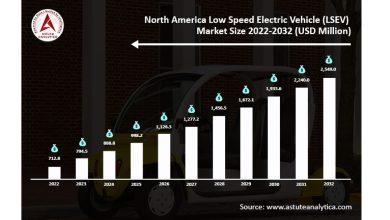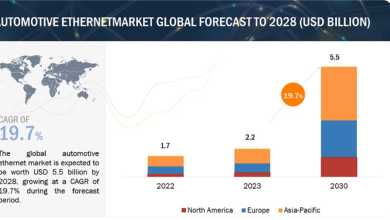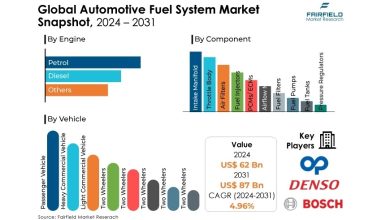In-car electronics market set to surge 9.6% CAGR by 2034
Visiongain has published a new report that the in-car electronics and communications market was valued at US$15,377.0 million in 2023 and is projected to grow at a CAGR of 9.6% during the forecast period 2024-2034.
In-Car Electronics and Communications Market Report 2024-2034: Forecasts by System Type (Infotainment Systems, Navigation Systems, Telematics Systems, Audio Systems, Connectivity Systems, Other), by Channel (Original Equipment Manufacturer (OEM), Aftermarket), by Vehicle Type (Commercial Vehicle, ICE Passenger Cars, Hybrid Passenger Cars, Electric Passenger Cars, Others) AND Regional and Leading National Market Analysis PLUS Analysis of Leading Companies AND COVID-19 Impact and Recovery Pattern Analysis.
Innovations on the Rise to Enhance In-Vehicle User Experience
In pursuit of enhanced connectivity solutions, vehicle safety improvements, and a superior in-car user experience, the automotive sector is embracing breakthrough technologies. Automotive infotainment emerges as a pivotal technology, enabling centralized control of diverse vehicle systems from a unified platform. Manufacturers are amplifying their efforts to enrich infotainment functionalities, emphasizing convenience and enjoyment for travellers. The integration of smart automotive technologies, including ADAS and sensors, within these systems is set to catalyse significant market expansion.
For instance, in January 2024, Valeo and Teledyne FLIR announced an agreement and signed their first contract to introduce the initial Automotive Safety Integrity Level (ASIL) B thermal imaging technology designed for night vision Advanced Driver Assistance Systems (ADAS). This technology, integrated with Valeo’s extensive sensor line-up and powered by its ADAS software stack, will enable functionalities like automatic emergency braking (AEB) during night-time conditions. This innovation targets both passenger and commercial vehicles, including applications in the realm of autonomous driving.
Automakers are prioritizing user experience (UX) in the design of the next generation of vehicles. The convergence of physical and digital elements, driven by trends such as electrification, connectivity, self-driving technology, and evolving ownership models, is set to create unparalleled user experiences. Successful automakers will excel in integrating technologies and services in ways that are both user-friendly and enjoyable for customers. Furthermore, in December 2023, Mercedes-Benz represents MBUX Virtual Assistant vision a significant evolution of the ‘Hey Mercedes’ voice assistant, introducing high-resolution game-engine graphics from Unity for a more immersive visual experience. This advanced AI-powered feature consolidates the intelligent systems of MBUX into a unified entity, offering customers a more natural and expressive interaction interface.
How has COVID-19 had a Significant Negative Impact on the In-Car Electronics and Communications Market?
The Covid-19 pandemic has had a devastating impact on the global economy and society. Governments worldwide responded by implementing nationwide lockdowns to mitigate the spread of the virus. While these measures were effective in curbing transmission, they severely disrupted vital industries, including the automotive sector. Key manufacturers either closed entirely as per government orders or operated with minimal staff to ensure personnel safety, leading to production halts at OEMs. This disruption cascaded through the entire value chain of major industries in major countries, adversely affecting auto spare parts production in smaller enterprises. Additionally, the sharp decline in customer demand for passenger vehicles contributed to revenue losses and created a severe liquidity crisis within the sector.
Also, the pandemic resulted in extensive production halts due to social distancing protocols and nationwide lockdowns. Governments implemented stringent health and safety regulations, leading to significant manufacturing shutdowns, which posed major challenges for the automotive market. The United States and Europe are still grappling with resuming regular vehicle production. For instance, in April 2020, vehicle sales in Europe, with an 84% drop compared to the same period in 2019.
The manufacturing shutdowns and reduced vehicle sales directly impacted the GDP of countries heavily reliant on the automotive sector. The decline in economic activity in this sector also affected related industries, including in-car electronics sector, as companies scaled back investments and expansion plans.
The COVID-19 pandemic had a multifaceted impact on the in-car electronics and communications market. This impact ranged from supply chain challenges to reduced consumer demand and financial strain within the automotive sector. The recovery process involved addressing these challenges while adapting to new market dynamics and consumer preferences post-pandemic.
How will this Report Benefit you?
Visiongain’s 294-page report provides 105 tables, 161 charts/graphs. Our new study is suitable for anyone requiring commercial, in-depth analyses for the in-car electronics and communications market, along with detailed segment analysis in the market. Our new study will help you evaluate the overall global and regional market for in-car electronics and communications market. Get financial analysis of the overall market and different segments including system type, sales channel, vehicle type, and combat support vehicles and capture higher market share. We believe that there are strong opportunities in this fast-growing in-car electronics and communications market. See how to use the existing and upcoming opportunities in this market to gain revenue benefits in the near future. Moreover, the report will help you to improve your strategic decision-making. This will allow you to frame growth strategies, reinforce the analysis of other market players, and maximize the productivity of the company.
What are the Current Market Drivers?
Speedy Advancements in Electronics Are Spurring Innovations in Vehicle Functionalities and Capabilities
The automotive industry has witnessed significant changes in recent years, mainly due to technological advancements. This transformation has shifted the focus from traditional mechanical engineering to a digital revolution. It’s reshaping mobility with concepts like shared, connected, and smart mobility. Automotive equipment manufacturers are meeting consumer demands for advanced information and entertainment systems. Touchscreen display consoles are now integrated into various parts of vehicles, providing a smartphone-like graphical interface to the infotainment and control system. Thin-film-transistor (TFT) LCDs are crucial components, offering the necessary resolution, contrast, and screen size. This evolution is driven by the increasing integration of advanced technologies, especially semiconductors, in modern vehicles.
These vehicles now incorporate sophisticated electronic components such as artificial intelligence, sensors, communication systems, and computing capabilities. This leads to improved safety, efficiency, and user satisfaction. For instance, in February 2023, US-based Cerence Inc., leading provider of AI technology for automotive applications, entered into a partnership with Yanfeng Visteon Automotive Electronics Co. Ltd. The company’s aims to integrate AI-powered communication technologies into SAIC-GM’s Buick CENTURY. Yanfeng will utilize Cerence’s in-car communication (ICC) system within an innovative infotainment setup tailored for the Buick CENTURY. This marks SAIC-GM as one of the early adopters of ICC technology in China.
Semiconductor manufacturers have responded by integrating display management support into their products. This simplifies design and reduces costs for these essential automotive features. Premium class vehicles lead in processing power and interactive computing capabilities. They are enhanced by the integration of social networking and IoT capabilities, enabling optimization of vehicle performance and occupant experience. Integrated circuits (ICs) are crucial in integrating enhanced functionality into microprocessors. This includes wireless connectivity for intra-vehicle communication and external linking with networks, traffic systems, or other vehicles. This connectivity offers potential for services like predictive maintenance, traffic management, and enhanced safety and emergency response. Further, in January 2022, STMicroelectronics, a leading global semiconductor company serving diverse electronics applications, announced the launch of a ground-breaking automotive satellite-navigation chip, named STA8135GA. This chip is designed to provide high-quality position data crucial for advanced driving systems.
Despite the complexity and safety concerns in automotive electronics design, manufacturers are providing development solutions that simplify design complexity and deliver enhanced safety, cost-effectiveness, and performance in areas like ADAS, motor control, engine management, in-vehicle interfaces, and external communications.
Autonomous Vehicle Development to Improve the Safety and Functionality
The rise of autonomous vehicle (AV) trends is driven by increasing demands for full autonomy, enhanced driver safety, and sustainability. Start-ups are at the forefront, developing AVs equipped with advanced features like driver-assistance systems (ADAS), LiDAR, and computer vision. These technologies, bolstered by deep learning algorithms and neural networks, enhance decision-making processes for critical functions such as steering and braking. Additionally, connectivity tools facilitate communication not only among driverless vehicles but also between vehicles and infrastructure. The industry is also witnessing trends related to the internet of things (IoT) and extended reality (XR).
IoT and sensor technology advancements facilitate precise monitoring of surroundings and obstacles. LiDAR sensors offer automation potential by penetrating fog and mist. The integration of AI algorithms and neural networks enhances autonomous driving safety and traffic efficiency. Blockchain adoption is another notable trend in the AV sector, enhancing vehicle tracking, payment security, and data management. Additionally, the utilization of vehicle-to-everything (V2X) technology enhances navigation and road safety for autonomous vehicles. However, increased connectivity necessitates robust cybersecurity measures to mitigate potential threats.
Where are the Market Opportunities?
Incorporating Artificial Intelligence (AI) and Internet of Things (IoT) Technologies into In-Car Electronics Opens Doors for New Features and Services
Automotive companies are leveraging AI, machine learning, and IoT technologies to optimize fleet operations. They assess performance-affecting factors and enhance passenger safety and experience through automation. Machine learning and AI are pivotal in automating processes, leading to operational efficiency by streamlining operations, reducing production cycles, and eliminating manual steps. Automotive firms can redirect their focus towards research & development, strategic initiatives, and enhancing systems for improved performance. This optimization at the operational level enables them to do so. For instance, in January 2024, Intel Corp. unveiled a new Software-Defined Vehicle SoC designed to integrate AI capabilities into future vehicles. Also, in September 2023, Continental teamed up with Google Cloud at the IAA MOBILITY 2023. This partnership aims to incorporate generative Artificial Intelligence (AI) into cars. The goal is to create a new generation of safe, efficient, and user-focused automotive solutions.
IoT plays a crucial role in empowering fleet managers, logistics operators, and drivers with timely and informed decision-making capabilities. This is achieved through edge processing, where data is collected and analysed in near-real-time. IoT-enabled devices with built-in processing capabilities establish the connectivity between vehicles, the cloud, and fleet management systems. For instance, edge-enabled IoT telematics solutions can gather, store, and analyse data on vehicle conditions and roadways using GPS technology, AI-enabled computer vision, and onboard diagnostics. These solutions enable monitoring of vehicle maintenance, driver behavior, and cargo management. By providing this data to fleet owners and managers, they lead to more efficient operations and improved overall performance.
Competitive Landscape
The major players operating in the in-car electronics and communications market are ALPS ALPINE CO., LTD, Bosch, Clarion Co., Ltd., Continental AG, Delphi Technologies, Denso Corporation, Garmin Ltd., Magneti Marelli, Mitsubishi Electric Corporation, Panasonic Corporation, Pioneer Corporation, Samsung Electronics Co., Ltd., Sony Corporation, TomTom International BV. These major players operating in this market have adopted various strategies. These strategies comprise M&A, investment in R&D, collaborations, partnerships, agreements, regional business expansion, and new product launches.




